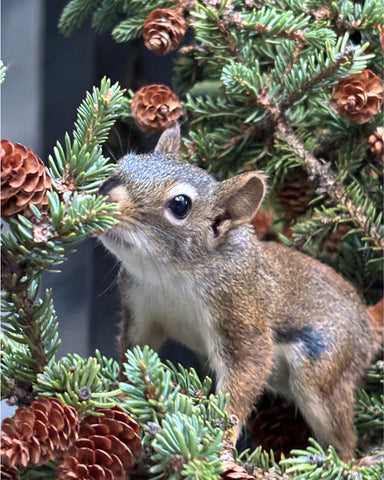👇 Psst... scroll down to fill out the details and add to your cart! 👇


Each package comprises a personalized certificate with the recipient's name, an 8 x 10 photo, and qualifies for a tax receipt.
🎁 Holiday Shipping Update: Due to the Canada Post strike, expect delays on physical sponsorships. Order by Dec 7 for the best chance of delivery. Digital sponsorships send instantly!
(Sciurus vulgaris).
Date of admission: Sept 17, 2025.
Reason for admission: Orphaned.
Patient History:
American red squirrels are widely distributed across North America. Their range includes most of Canada and portions of the United States east of the Rocky Mountains. Within their range, each American red squirrel fiercely defends a small, year-round exclusive territory. Each squirrel will have several nests, including loosely constructed tree nests, holes in tree trunks, and weather-tight winter nests built in dense tree foliage. American red squirrels are also referred to as North American red squirrels, pine squirrels, chickarees, and fairydiddles.
American red squirrels are primarily granivores, meaning that they feed on the seeds of plants as a main or exclusive food source. These squirrels eat primarily the seeds of conifer cones, although they have been known to also feed on mushrooms, willow leaves, poplar buds, bearberry flowers, and berries, as well as birds' eggs. These squirrels routinely create a midden, or ground burrow, where they stash food to last throughout the winter. These food stashes are critical for a squirrel’s survival through the winter months when food is scarce.
American red squirrels are well adapted for living in forest habitats. Their strong claws, powerful hind legs, and muscled bodies allow them to easily move along tree branches and up and down tree trunks.
Female red squirrels breed and give birth to one litter per year. After a gestation period of 35 days, the female gives birth to her litter in one of her most secure nests. Female red squirrels raise the baby squirrels on their own. Litter sizes typically range from one to five offspring. Young squirrels develop quickly, first emerging from their nest around 42 days and are weaned eight weeks after they are born.
This juvenile Red Squirrel was rescued after being found alone in Canmore with no adults nearby. He was approximately five weeks old at the time of rescue and weighed only 49 grams. Given the time of year and his size, we suspect he is part of a late-season litter.
Upon arrival, he was placed on a specialized formula diet to support his growth and development. Although he has since transitioned to solid foods, he is still too young to be reintroduced to the wild and would not have enough time to build a food cache before winter. He will remain at AIWC over the winter and be released in early spring, once he is old enough to forage and thrive on his own.
